Beauties of orchids with full careful care will surely please with luxurious flowering. We must take into account all the subtleties of growing, including knowing which pots for orchids are needed. Wrong choice - and the plant will not give a flower stalk, it will often hurt, and the owner will never wait for the flowers of the "butterflies".
Content
- 1 Why it is important to choose the right vessel for growing orchids
- 2 Criterias of choice
- 3 Types of pots for orchids: a description of the materials, features
- 4 Orchid pot: how to choose a vessel with additional options
- 5 Planter and pot: what is the difference
- 6 Dimensions and shapes of pots for orchids
- 7 How to make a pot for orchids with your own hands
Why it is important to choose the right vessel for growing orchids
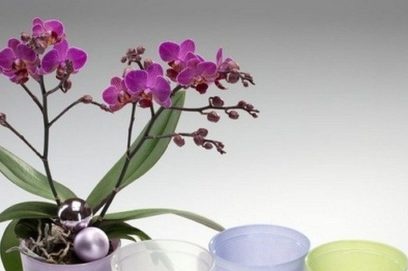 Phalaenopsis, Cattleya, cymbidium and other representatives of a large family are epiphytes or lithophytes, which grow in the wild in tropical forests. Lithophytes are adapted to life on rocks, stones, while epiphytes settle on other plants and use them as a support.
Phalaenopsis, Cattleya, cymbidium and other representatives of a large family are epiphytes or lithophytes, which grow in the wild in tropical forests. Lithophytes are adapted to life on rocks, stones, while epiphytes settle on other plants and use them as a support.
In order for the orchid to bloom in the conditions of a city apartment alien to it, it is necessary to create optimal conditions. Despite the selection, the natural specificity takes its toll, and plants have to adapt to indicators of humidity, temperature, watering, nutrition. Florists are able to provide comfort for the inhabitants of the tropics, picking up a pot and the right substrate for orchids.
Criterias of choice
Choosing a pot for an orchid is necessary taking into account a number of criteria:
- type of orchid;
- size of shoots, bulbs and root system;
- the presence of drainage holes for the outflow of moisture;
- container material.
Orchids are capricious, demanding on aeration of the root system, on the moisture content of the substrate.
Mandatory drainage
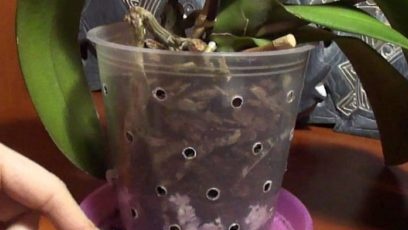 Experienced growers know in which pot the orchid should grow, which does not tolerate overmoistening of the root system. Therefore, instead of the usual nutritious soil mixture a substrate is prepared for them from the bark and other components, and drainage holes are necessarily made in the tank.
Experienced growers know in which pot the orchid should grow, which does not tolerate overmoistening of the root system. Therefore, instead of the usual nutritious soil mixture a substrate is prepared for them from the bark and other components, and drainage holes are necessarily made in the tank.
In flower shops you can see transparent orchid pots with holes not only in the bottom, but also on the walls of the lower part. You can also always drill holes to drain excess moisture yourself.
Root aeration
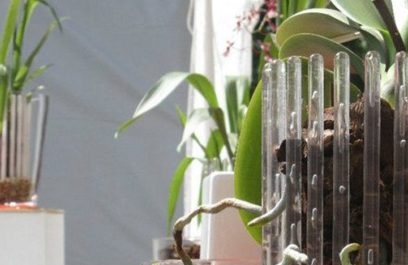 The roots of tropical flowers are covered with a special layer of dead cells - velamen. It contains moisture reserves, due to which orchids undergo drought in natural conditions. Velamen grows only in air and does not form with constant substrate moisture. It is required to provide aeration of the plant root system, otherwise only the rhizoderma without velamen will remain. The width of the velamen is completely dependent on compliance with the methods of care, including the correct selection of the pot.
The roots of tropical flowers are covered with a special layer of dead cells - velamen. It contains moisture reserves, due to which orchids undergo drought in natural conditions. Velamen grows only in air and does not form with constant substrate moisture. It is required to provide aeration of the plant root system, otherwise only the rhizoderma without velamen will remain. The width of the velamen is completely dependent on compliance with the methods of care, including the correct selection of the pot.
Temperature mode
Under natural conditions, exotics themselves control their condition. This is more difficult to do in the house, since the roots of the plant should feel complete comfort: without hypothermia, overheating. With sudden changes, the presence of condensation, orchids get sick, dry out, die. Capacities are selected taking into account this indicator, achieving the optimal growing regime.
Transplant Safety
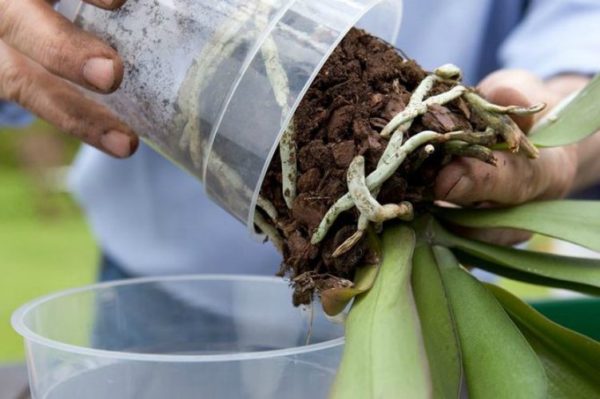 The size of the container for the flower is determined by the volume of the roots. The diameter of the container is selected wider by 2-4 cm. It is impossible that the walls of the vessel constrain the roots, but at the same time it is not recommended to take too wide dishes.
The size of the container for the flower is determined by the volume of the roots. The diameter of the container is selected wider by 2-4 cm. It is impossible that the walls of the vessel constrain the roots, but at the same time it is not recommended to take too wide dishes.
The upper part should be wide, narrow and cone-shaped patterns for orchids are undesirable. In tight pots, the roots grow to the walls of the container and are damaged during transplantation, the plant experiences stress and takes root in a new place for a long time. The approximate size of the neck is determined by the height of the pot (must be equal).
Types of pots for orchids: a description of the materials, features
Landing containers are bought in stores, do it yourself, using improvised materials. Ready-made models of the Crown, designed specifically for orchids, as well as ordinary plastic food pails, wicker baskets are popular.
Plastic
Plastic orchid pots are the most popular. Such vessels are easy to care for, have transparent walls, which is especially important for members of the family, tolerate both small temperature drops and sunlight. Lovers often worry about the walls, ask experts whether it is necessary to plant capricious orchids in a transparent pot. This is necessary for a number of species in which sunlight is mandatory for the root system. Otherwise, the process of photosynthesis is blocked. In all other cases, the characteristic is not so important.
Purchased plastic pots are already equipped with drainage holes, in home-made dishes they are made independently. If necessary, it is easy to add 2-3 holes, if required for a particular flower.
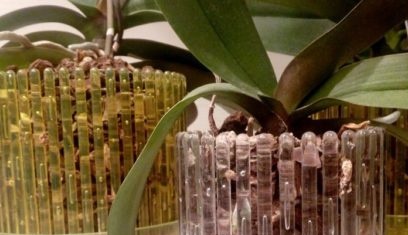 In flower shops, Corona plastic pots are presented, based on flexible, circular rods. The walls transmit light, aeration is provided for the roots of the plant, so there is no particular problem with an excess of moisture. The kit includes a pallet whose diameter is wider than the bottom of the pot. Coarse sand and stones are added to the pallet for more comfortable orchid cultivation.
In flower shops, Corona plastic pots are presented, based on flexible, circular rods. The walls transmit light, aeration is provided for the roots of the plant, so there is no particular problem with an excess of moisture. The kit includes a pallet whose diameter is wider than the bottom of the pot. Coarse sand and stones are added to the pallet for more comfortable orchid cultivation.
Such a pot is suitable for Phalaenopsis, Wanda, since their roots require light to participate in photosynthesis. But plants with pseudobulbs grow well in them: Cumbria, Denndrobium, Brassia. If suddenly the roots of the flower sprouted through the holes, the plastic is easy to cut and without damage to get a leaf outlet.
In addition, through transparent walls it is clearly visible how orchid roots develop, what is the state of the substrate, whether there is moisture stagnation. This simplifies maintenance, so plastic containers are usually recommended for beginner growers.
Clay
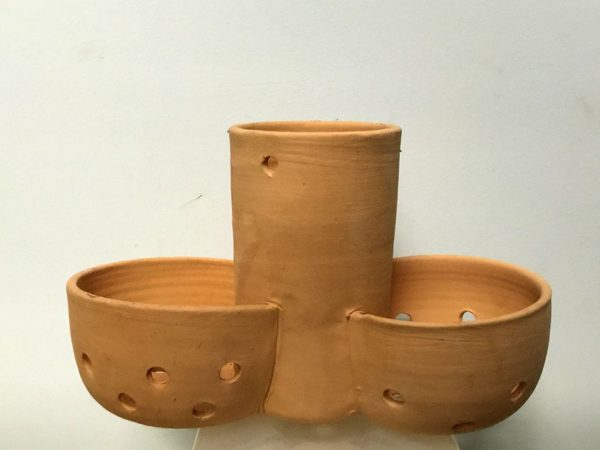 Exotic flowers in clay pots grow well. It is a practical, environmentally friendly material, without harmful impurities and additives. Air passes through the pores in the walls, root aeration is ensured, there is no stagnation of moisture. But many are interested in whether it is possible to plant an orchid in an opaque pot? This is allowed for certain species whose roots do not need sunlight.
Exotic flowers in clay pots grow well. It is a practical, environmentally friendly material, without harmful impurities and additives. Air passes through the pores in the walls, root aeration is ensured, there is no stagnation of moisture. But many are interested in whether it is possible to plant an orchid in an opaque pot? This is allowed for certain species whose roots do not need sunlight.
Unlike unstable plastic pots, clay containers do not turn over under the weight of orchid stems and peduncles; they are more stable. But such utensils have disadvantages:
- in a city apartment near heating systems (especially in winter) the walls intensively evaporate moisture. This leads to hypothermia of the root system and flower diseases;
- inside, the roots of the plant are attached to clay porous rough walls. When transplanting, it is impossible to avoid damage and deformation;
- clay is little suitable for orchids, whose root system is involved in photosynthesis and they need light;
- after watering and top dressing, a layer of salts is deposited on the inner walls of the clay container. This affects aeration, porosity and the plant in such a vessel feels uncomfortable;
- fragility (beats when dropped).
Ceramics
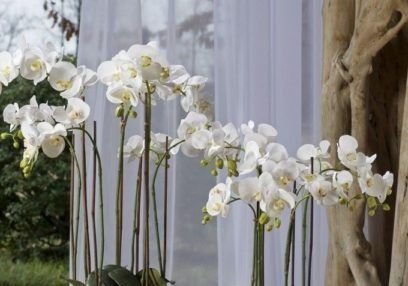 Unlike pottery, ceramic pots are glazed on all sides. The problem of attaching roots to the walls disappears, the plant feels well and does not experience stress during transplantation. The containers are stable, beautiful in appearance, so the orchids in them look great.
Unlike pottery, ceramic pots are glazed on all sides. The problem of attaching roots to the walls disappears, the plant feels well and does not experience stress during transplantation. The containers are stable, beautiful in appearance, so the orchids in them look great.
“Minus” - ceramics do not accumulate, but give off heat. Therefore, such material is suitable for hot rooms, but when growing orchids in cool it is advisable to choose a more convenient plastic.
In such pots, experienced flower growers often grow their handsome men, who find it easier to provide comfortable conditions for the root system of orchids. Through the walls there is no way to control the state of the substrate, the roots of the plant, so you need to take care of high-quality drainage in advance.
Glass
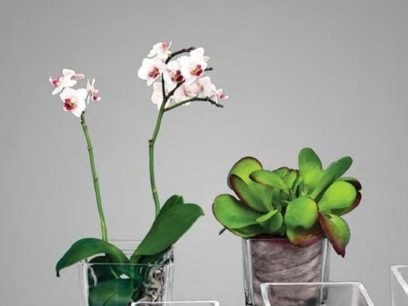 Recommended for experienced orchid lovers who know in practice all the subtleties of growing exotic flowers. In terms of attractiveness and beauty, glass containers are superior to others. Manufacturers offer vessels "aquariums", stylish glasses in which orchids look incredibly beautiful. But there are more shortcomings in such dishes.
Recommended for experienced orchid lovers who know in practice all the subtleties of growing exotic flowers. In terms of attractiveness and beauty, glass containers are superior to others. Manufacturers offer vessels "aquariums", stylish glasses in which orchids look incredibly beautiful. But there are more shortcomings in such dishes.
"Minuses":
- due to the limited model range, it is difficult to choose a pot for a certain type and size of the plant;
- it is impossible to make additional drainage holes;
- condensate harmful to orchids often accumulates on the walls;
- green algae grows on the roots, mucus appears, which is detrimental to plants.
It is required to constantly monitor the substrate moisture content, 2-3 times a year, or even more often, to change the nutrient mixture. In addition, glass pots are impractical and can break when rearranged.
Metal
Pots of metal are not very popular with gardeners, as they are not suitable for growing flowers. An exception is wicker baskets made of metal bars or strips into which the substrate is laid.
Bamboo
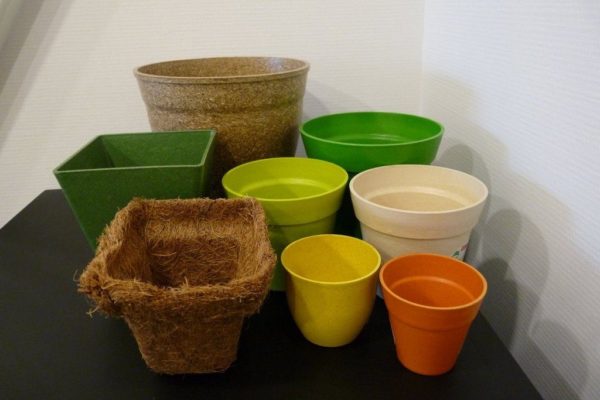 Containers made of bamboo are wicker pots of various configurations (deep, shallow, in the form of plates, baskets). The porous inside of the bamboo stems “breathes”, there is no stagnation of moisture, there is a full air exchange for the roots of the plant. The roots do not overheat, do not freeze, the orchid feels like in nature.
Containers made of bamboo are wicker pots of various configurations (deep, shallow, in the form of plates, baskets). The porous inside of the bamboo stems “breathes”, there is no stagnation of moisture, there is a full air exchange for the roots of the plant. The roots do not overheat, do not freeze, the orchid feels like in nature.
But in such pots, the substrate dries faster, so you need to constantly monitor the level of humidity and water the flower in a timely manner.
In wicker bamboo pots in the form of baskets, orchid plants with peduncles are often planted, the growth of which goes down. When backfilling the substrate, larger components are laid on the bottom so that the nutrient mixture does not spill out through the cracks.
Orchid pot: how to choose a vessel with additional options
At the same time, many use transparent pots for all types of orchids of this large family. The explanation is simple: it is easier to control the state of the root system of plants, the humidity of the substrate. Through the transparent walls, it is easy to notice any changes: a change in the color of the roots, the appearance of spots, rot, mucus, parasites. This helps to quickly take action and save the flower from death.
In flower shops you can buy pots for orchids with additional options:
- automatic watering;
- immersion pallets;
- phyto lighting.
Tanks with automatic irrigation operate on the principle of capillary irrigation, equipped with tubes indicators and reservoirs for water supply. In fact, this is a double pot - a capacity for planting and a pot for orchids, and how to use it depends on the design. Kits with collapsible automatic watering systems, indicators, as well as a drainage mixture for dispensing a water supply are available. Maintenance with such pots is easier, but they do not completely replace the care of the plant.
Planter and pot: what is the difference
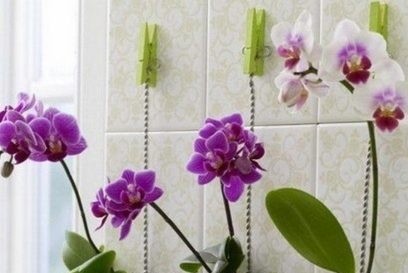 Orchids, like other flowers in apartments, are often grown in flower pots. Beautiful compositions add additional charm to tropical beauties, they look presentable and stylish. The design of the planter is different; it is not a pot in the usual sense of the word.
Orchids, like other flowers in apartments, are often grown in flower pots. Beautiful compositions add additional charm to tropical beauties, they look presentable and stylish. The design of the planter is different; it is not a pot in the usual sense of the word.
Features of a cache-pot:
- performs a decorative and protective function;
- the plant is in a double tank (there is a layer for air);
- walls without drainage holes;
- various materials are used (plastic, wood, ceramics, gypsum, plastic)
- bigger pot in size.
A container with a plant is installed in the container, observing the space between their walls. The air gap prevents the accumulation of moisture. A designer flower pot for orchids is easy to do with your own hands.
Dimensions and shapes of pots for orchids
Lush flowering is achieved only with proper care, compliance with the rules of cultivation and, oddly enough, with the right purchase of the pot. Orchids do not like to grow in large containers, so they select vessels so that the roots fit into them without free space.
When transplanting a plant, the container volume can be slightly larger, by 2-3 cm. But they do not pick up pots for growth, especially for orchids such as paphiopedilum.
The flowers planted by the group in one container look spectacular. But you need to calculate the volume of the roots and then choose the appropriate capacity. Pots cones for planting orchids are not suitable.
Pots for mini orchids
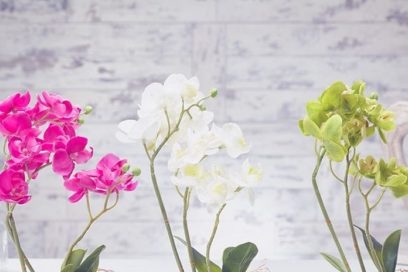 For miniature plants, it is best to buy or make a transparent pot yourself. Such specimens love increased moisture, but at the same time suffer from an excess of water. In transparent containers it will be easier to control the roots and substrate for babies.
For miniature plants, it is best to buy or make a transparent pot yourself. Such specimens love increased moisture, but at the same time suffer from an excess of water. In transparent containers it will be easier to control the roots and substrate for babies.
The orchid family has special species, for example, Miltonia. It is often grown in aquariums, placing several bushes inside. Each plant has its own "living space", for which they put additional transparent plastic bottles. It turns out a pot in the greenhouse. Tanks are opened for air inflow, and the aquarium itself is covered from direct rays of the sun and kept in small partial shade.
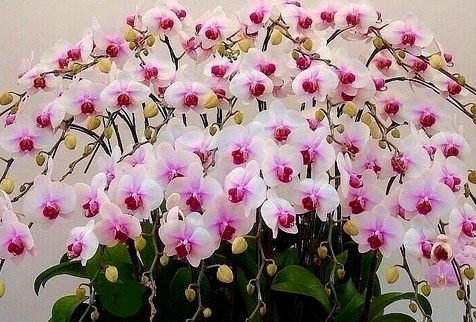 You may be interested in:
You may be interested in:Planting kids
For breeding your favorite plant species use kids. They are easy to grow in miniature pots (plastic cups) so that the roots are in a small crowded place. In spacious containers, kids often rot. Practical gardeners often make greenhouses from polyethylene or grow plants in pieces of polystyrene foam.
Gardeners have no shortage of pots and pots for orchids. In specialized stores, a huge assortment of models from glass, plastic, and ceramics is presented. Bamboo baskets and flowerpots are popular, Corona pots with a needle design are simplified, which simplifies plant care.
Many prescribe containers and containers through online stores. But it is advisable to find reliable manufacturers and first order 1-2 pots for quality control.
How to make a pot for orchids with your own hands
Having studied all the requirements for containers for growing orchids, it is easy to make a pot yourself using improvised materials.There are desktop designs, as well as tanks for wall mounting. It is up to the grower to decide whether or not to make a vessel transparent.
The right plastic pot for orchids
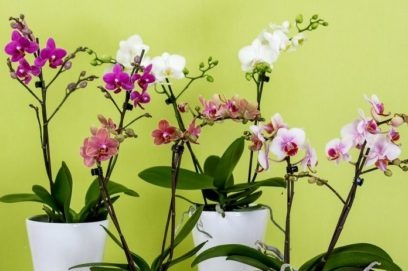 Suitable bases for transparent containers are:
Suitable bases for transparent containers are:
- plastic or plastic food baskets;
- plastic containers of various sizes;
- plastic buckets (from pickles, mayonnaise, jam);
- standard plastic flower pots;
- plastic bottles.
Holes in a plastic pot for an orchid are made in the bottom and along the walls of the container. To do this, the iron rod or nail is heated on the stove and the holes are carefully pierced. Excess plastic from the edges of the holes is cut off, the container is placed on a pallet or in a cache-pot.
Orchids from cuts of a tree, a tree bark, plastic baskets, containers from wooden dice look beautiful. Also, for the cultivation and breeding of representatives of the tropics, glass aquariums and gypsum pots are used. The flowerpots for orchids with decor made of beads and glass are interesting, and how to use improvised materials is up to the flower grower to decide.
From boards or dice
Spectacular containers are obtained from thin boards, wooden dice. Previously, the material is ground, then treated with an antiseptic. They collect the dies into a single unit with the help of a wire, use a wooden circle with holes for the base.
Large orchids are best grown in pots from dies with a mesh bottom. They are woven from wire, and when laying the substrate at the bottom, large pieces of expanded clay, shards, pebbles are placed. It is undesirable to use glue for assembly, screws, wire, small cloves are better suited.
Desktop models are equipped with legs for stability, wall-mounted containers are wound with one large side to conveniently attach the container to a vertical surface.
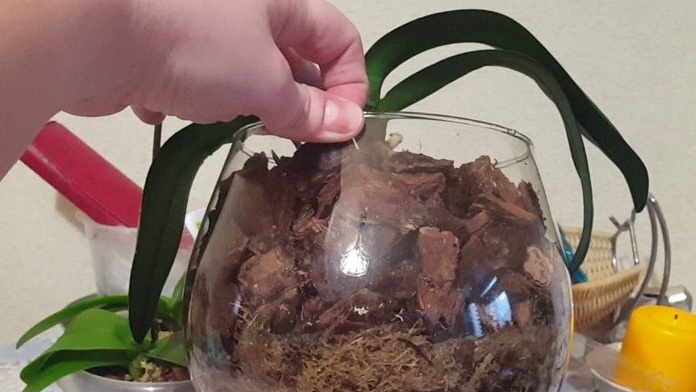 You may be interested in:
You may be interested in:Traffic jams
It is convenient to plant miniature orchid species in cork pots. Bottle caps are made of porous natural materials, allow air, moisture, and provide ventilation to the roots of the plant.
A hole is made in the cork, an orchid is placed in it, fixed on the basis of fishing line or thin wire. With the help of such unusual "pots" they create entire compositional rows of beautifully flowering plants.
Blocks of tree bark
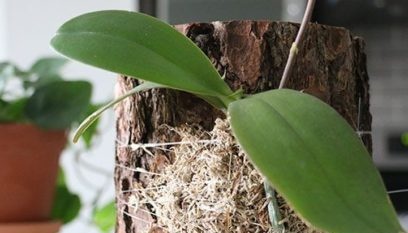 Epiphytic species are grown on blocks of bark. On the surface lay the substrate, a special granular hydrogel for orchids, moss. Then place the plant, fixing it with coconut fiber. In such “apartments”, the capricious inhabitants of the tropics feel as if in the wild, grow well and bloom.
Epiphytic species are grown on blocks of bark. On the surface lay the substrate, a special granular hydrogel for orchids, moss. Then place the plant, fixing it with coconut fiber. In such “apartments”, the capricious inhabitants of the tropics feel as if in the wild, grow well and bloom.
Demanding and demanding orchids require a quality pot. When choosing a container, take into account the features of the orchid species, plant size, and the presence of drainage. In transparent plastic pots, the plant does not get sick, blooms profusely and lives long.

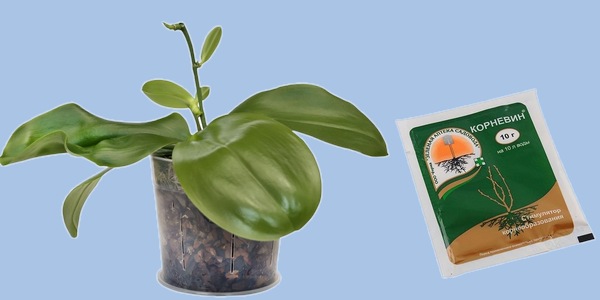
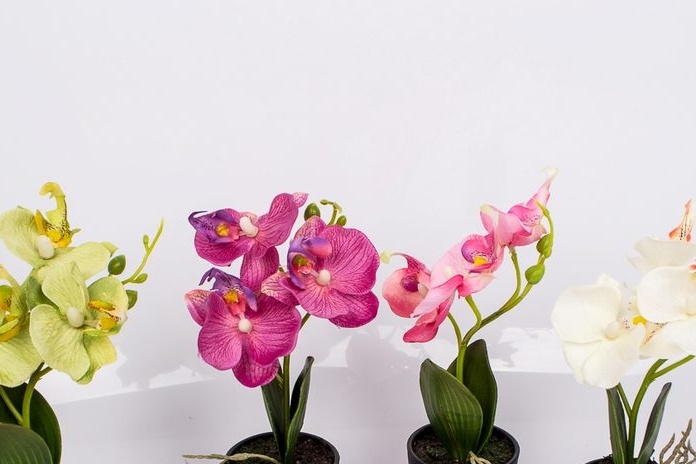
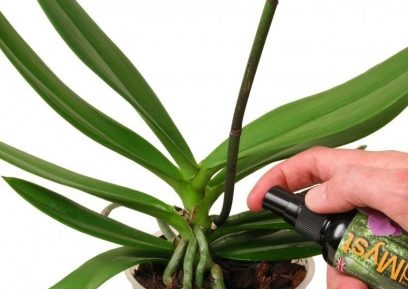
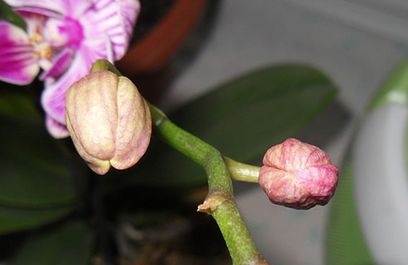 Reasons why orchids fall flowers and what to do
Reasons why orchids fall flowers and what to do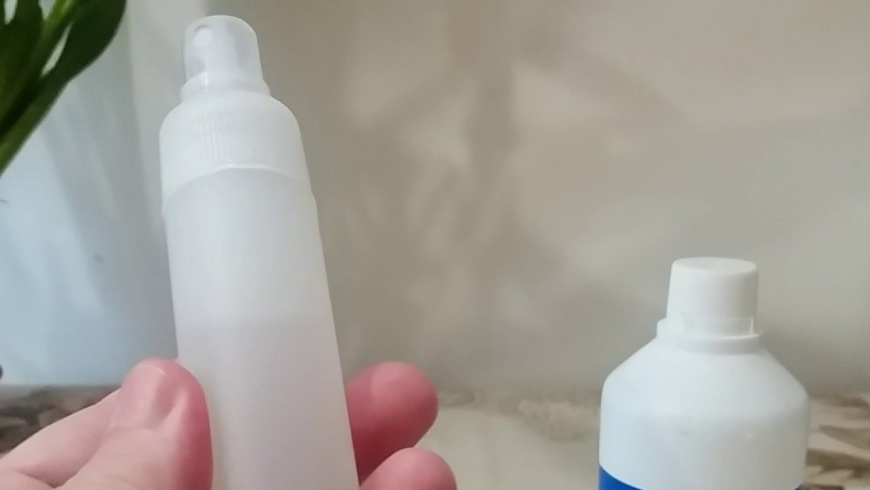 How to use hydrogen peroxide for orchids and why
How to use hydrogen peroxide for orchids and why Midges are wound up in the orchid: effective ways to get rid
Midges are wound up in the orchid: effective ways to get rid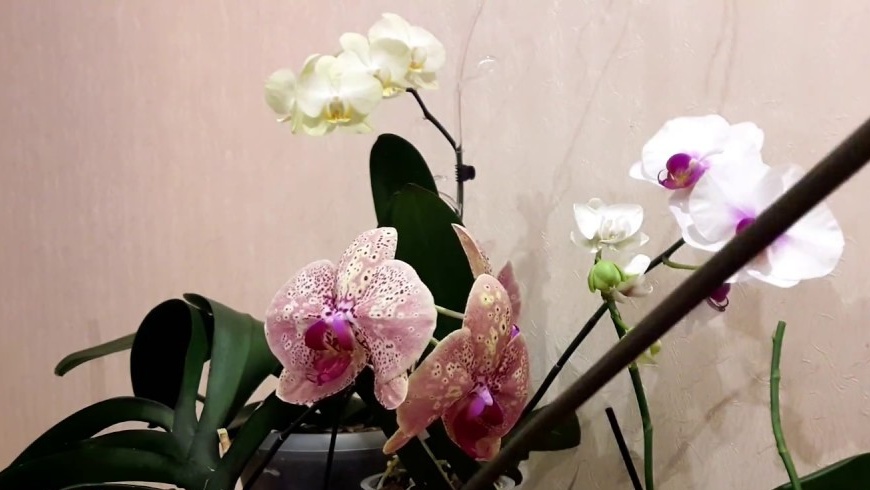 Is it possible to transplant an orchid during flowering
Is it possible to transplant an orchid during flowering